
Recipe: Try it with cherries, apricots or any seasonal favorite
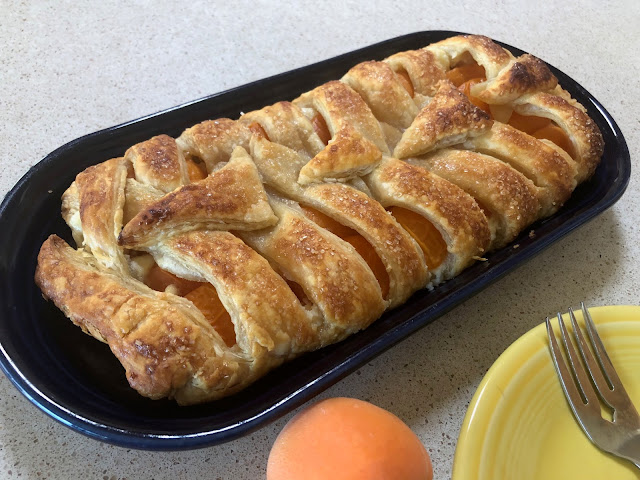 |
|
Fresh apricots are baked in puff pastry on a bed of lemony cream cheese. It's
a special breakfast treat. (Photos: Kathy Morrison)
|
I have no problem using kitchen shortcuts when the results are delicious and reliable. Frozen puff pastry is one of the best. (No way am I making my own.)
Pastries aren't diet food, but occasionally a treat for a special breakfast (Father's Day, for example) is a lot of fun. This recipe comes together easily, with some cream cheese, lemon zest and a pint or so of fresh fruit. Blueberries are spectacular in this, but cherries, apricots, peaches or nectarines are great, too. Strawberries might be too juicy, but good strawberry preserves are an option for the strawberry fan.
One box of frozen puff pastry makes two of these breakfast braids, so it's easy to vary the fruit to please everyone. Or make just one now and save the second frozen dough for another occasion.
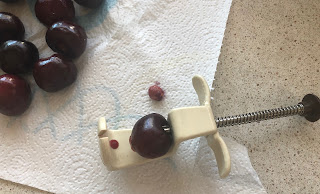 |
|
A cherry pitter is a must if you make a lot of
cherry dishes.
|
Note: I made my two braids separately, using 14 halved cherries for one and 5 quartered apricots for the other.
Fresh fruit breakfast braid
Makes two braids, 5 or 6 slices each
Ingredients:
One 17.3-ounce package puff pastry dough, defrosted but cold
One 8-ounce package regular (block) cream cheese, room temperature or softened slightly in the microwave
4 tablespoons sugar
Zest from 1 lemon
2 to 3 cups prepared fruit (such as blueberries, pitted and halved cherries, or pitted and sliced apricots or peaches, or 1 to 1-1/2 cups of two kinds)
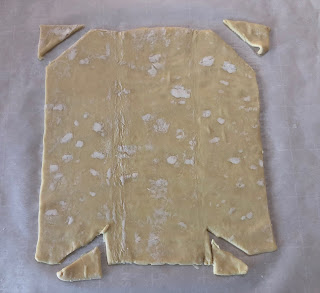 |
|
Cutting the triangles provides a guide
for making the braid.
|
Cream or milk for brushing the pastry
Coarse sugar for sprinkling (optional)
Instructions:
Preheat oven to 400 degrees.
Prepare the fruit desired, and set it aside while you make the filling.
In a medium bowl, stir the lemon zest and sugar into the softened cream cheese until thoroughly incorporated. Set aside while the dough is being prepared.
Remove 1 dough from the box; leave the other in refrigerator to stay cold while you're working on the first.
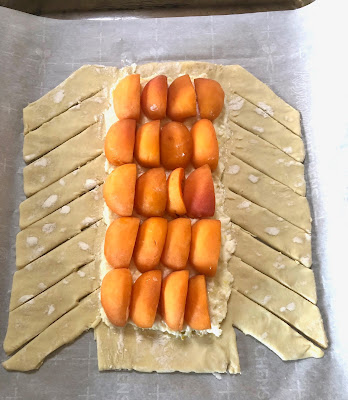 |
|
The cream cheese and fruit are in place and the pastry
is ready to braid.
|
Place the first dough on a large piece of parchment paper with one of the short sides in front of you. Unfold the dough, removing the little papers that are packed with it. Using a rolling pin, lightly roll it thinner, generally retaining the shape.
Using a sharp knife, cut two small triangles off the upper corners of the dough (about 2 inches in from the corners). Then cut two triangular notches out of the lower edge of dough. (See photo for example.) This will allow you to fold the ends up to keep the filling from spilling out. Save the triangles for decor if desired.
Now cut the braid pieces, following the angle of the upper corners of the dough. They can be thick or thin, but there should be an equal number on each side.
Slide the parchment paper onto the pan you'll be using to bake with. Set the pan in the refrigerator or even the freezer to stay cold while you work on the second dough.
After the second dough is prepared on a second piece of parchment paper, set it aside. Remove the first dough, still on the pan, from the refrigerator.
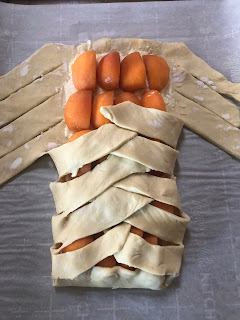 |
| Overlap the strips to make the braid. |
Spread half the cream cheese mixture over the center part of the dough, leave about an inch or dough uncovered at each end. Arrange the desired fruit on top of the cream cheese.
Then braid the dough, starting at the bottom where the notches are. Fold up the uncovered dough, then alternately bring the dough strips up and over the fruit. The strips should overlap a little; if they don't stick together, wet the undersides with a little water.
When you get to the end, tuck the upper uncovered flap of dough up under the last strips. If desired, use the cut-off triangles to decorate the top. Brush the dough with cream or milk and sprinkle on the coarse sugar if using.
If there's room on the pan, slide the second dough and its parchment paper on it, and repeat the process with the rest of the cream cheese and fruit. If there's not enough room, slide the dough and paper onto a second pan and create the braid there.
Put both pans in the oven and bake 25-30 minutes, or until golden brown. Let cool on wire racks after baking for about 10 minutes. The braid can be served warm, room temperature or even cold.
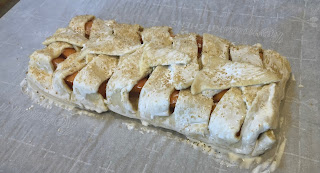 |
| All ready for the oven. |
Comments
0 comments have been posted.Sacramento Digs Gardening to your inbox.
Food in My Back Yard Series
May 6: Maintain soil moisture with mulch for garden success
April 29: What's (already) wrong with my tomato plants?
April 22: Should you stock up on fertilizer? (Yes!)
April 15: Grow culinary herbs in containers
April 8: When to plant summer vegetables
April 1: Don't be fooled by these garden myths
March 25: Fertilizer tips: How to 'feed' your vegetables for healthy growth
March 18: Time to give vegetable seedlings some more space
March 11: Ways to win the fight against weeds
March 4: Potatoes from the garden
Feb. 25: Plant a fruit tree now -- for later
Feb. 18: How to squeeze more food into less space
Feb. 11: When to plant? Consider staggering your transplants
Feb. 4: Starting in seed starting
Sites We Like
Garden Checklist for week of May 4
Enjoy this spring weather – and get gardening!
* Plant, plant, plant! It’s prime planting season in the Sacramento area. Time to set out those tomato transplants along with peppers and eggplants. Pinch off any flowers on new transplants to make them concentrate on establishing roots instead of setting premature fruit.
* Direct-seed melons, cucumbers, summer squash, corn, radishes, pumpkins and annual herbs such as basil.
* Harvest cabbage, lettuce, peas and green onions.
* In the flower garden, direct-seed sunflowers, cosmos, salvia, zinnias, marigolds, celosia and asters. (You also can transplant seedlings for many of the same flowers.)
* Plant dahlia tubers. Other perennials to set out include verbena, coreopsis, coneflower and astilbe.
* Transplant petunias, marigolds and perennial flowers such as astilbe, columbine, coneflowers, coreopsis, dahlias, rudbeckia and verbena.
* Keep an eye out for slugs, snails, earwigs and aphids that want to dine on tender new growth.
* Feed summer bloomers with a balanced fertilizer.
* For continued bloom, cut off spent flowers on roses as well as other flowering plants.
* Add mulch to the garden to maintain moisture. Mulch also cuts down on weeds. But don’t let it mound around the stems or trunks of trees or shrubs. Leave about a 6-inch to 1-foot circle to avoid crown rot or other problems.